Advanced Applications of Fuzzy Systems and Computational Intelligence in Decision-Support Systems
Abstract
This paper systematically explores cutting-edge fuzzy systems—such as Type-2, Pythagorean, and Neutrosophic sets—and computational frameworks like Granular Computing (GrC) and Z-numbers, aligning them with practical applications in intelligent systems. The study addresses critical gaps in translating theoretical models into real-world solutions, emphasizing methodological innovations and interdisciplinary challenges. Fuzzy systems, particularly Type-2 Fuzzy Sets (T2FS), enhance decision-making in dynamic environments by modeling second-order uncertainties, as demonstrated in adaptive control systems. Intuitionistic Fuzzy Sets (IFS) extend classical fuzzy logic by incorporating non-membership degrees, proving effective in multi-criteria decision analysis (e.g., sustainable supply chain management). Pythagorean Fuzzy Sets (PFS) further generalize IFS by allowing squared membership values, improving flexibility in high-stakes scenarios like e-commerce demand forecasting. Advanced extensions are analyzed for cybersecurity and crisis management applications, including Neutrosophic Sets (Handling indeterminacy) and soft sets (Managing incomplete data). In computational intelligence, GrC partitions data into hierarchical granules, enabling context-aware decisions in smart traffic systems. Z-numbers and D-numbers —tools for reliability-based uncertainty modeling—are evaluated for risk assessment in infrastructure projects, though their integration with Machine Learning (ML) remains underexplored. Hybrid models, such as Fuzzy-Genetic Algorithms (GAs), showcase practical benefits, reducing energy consumption in smart grids by 18. Methodological challenges include translating technical terms (e.g., "complement" in fuzzy logic) across interdisciplinary teams, requiring context-aware approaches to preserve semantic accuracy. Case studies highlight a 22% reduction in diagnostic errors using Pythagorean fuzzy systems in healthcare and optimized supplier selection in automotive supply chains via IFS. This paper underscores the transformative potential of fuzzy systems and computational intelligence while advocating for standardized frameworks, improved interpretability of hybrid models, and broader adoption of Z-numbers in industry. Future research should prioritize bridging theoretical advancements with scalable, real-world implementations to address global challenges in sustainability, healthcare, and smart infrastructure.
Keywords:
Type-2 fuzzy systems, Neutrosophic decision-making, Z-number reliability modelingReferences
- [1] Mendel, J. M. (2024). Uncertain rule-based fuzzy systems. In Explainable uncertain rule-based fuzzy systems. Springer. https://doi.org/10.1007/978-3-319-51370-6
- [2] Zadeh, L. A. (2011). A note on Z-numbers. Information sciences, 181(14), 2923–2932. https://doi.org/10.1016/j.ins.2011.02.022
- [3] Yager, R. R. (2014). Pythagorean membership grades in multicriteria decision making. IEEE transactions on fuzzy systems, 22(4), 958–965. https://doi.org/10.1109/TFUZZ.2013.2278989
- [4] Atanassov, K. T. (1999). Intuitionistic fuzzy sets. In Intuitionistic fuzzy sets: Theory and applications (pp. 1–137). Heidelberg: Physica-Verlag HD. https://doi.org/10.1007/978-3-7908-1870-3_1
- [5] Pedrycz, W. (2016). Granular computing: Analysis and design of intelligent systems. Taylor & Francis group. http://dx.doi.org/10.1201/9781315216737
- [6] Smarandache, F. (2006). Neutrosophic set - a generalization of the intuitionistic fuzzy set. 2006 IEEE international conference on granular computing (pp. 38–42). IEEE. https://doi.org/10.1109/GRC.2006.1635754
- [7] Castillo, O., & Melin, P. (2012). Recent advances in interval type-2 fuzzy systems. Springer Science & Business Media. http://dx.doi.org/10.1007/978-3-642-28956-9
- [8] Ross, T. J. (2005). Fuzzy logic with engineering applications. John Wiley & Sons. https://doi.org/10.1002/9781119994374
- [9] Kahraman, C. (2008). Fuzzy multi-criteria decision making: Theory and applications with recent developments. Springer Science & Business Media. https://doi.org/10.1007/978-0-387-76813-7
- [10] Liu, H., & Zhang, L. (2018). Fuzzy rule-based systems for recognition intensive classification in granular computing context. Granular computing, 3, 355–365. https://doi.org/10.1007/s10462-016-9496-7
- [11] Jang, J. S. R., Sun, C. T., Mizutani, E., & Ho, Y. C. (1997). Neuro-fuzzy and soft computing-a computational approach to learning and machine intelligence. IEEE transactions on automatic control, 42(10), 1482–1484. https://doi.org/10.1109/TAC.1997.633847
- [12] Sadeghian, A., Mendel, J. M., & Tahayori, H. (2013). Advances in type-2 fuzzy sets and systems. Springer. https://doi.org/10.1007/978-1-4614-6666-6
- [13] Peng, X., & Selvachandran, G. (2019). Pythagorean fuzzy set: State of the art and future directions. Artificial intelligence review, 52(3), 1873–1927. https://doi.org/10.1007/s10462-017-9596-9
- [14] Huynh, V. N. (2019). Uncertainty management in machine learning applications. International journal of approximate reasoning, 107, 79–80. http://dx.doi.org/10.1016/j.ijar.2019.02.001
- [15] Abiyev, R. H. (2016). Z number based fuzzy inference system for dynamic plant control. Advances in fuzzy systems, 2016, 1–7. http://dx.doi.org/10.1155/2016/8950582
- [16] Chen, S. M., & Tanuwijaya, K. (2011). Fuzzy forecasting based on high-order fuzzy logical relationships and automatic clustering techniques. Expert systems with applications, 38(12), 15425–15437. https://doi.org/10.1016/j.eswa.2011.06.019
- [17] N. Karnik, N., & M. Mendel, J. (2001). Operations on type-2 fuzzy sets. Fuzzy sets and systems, 122(2), 327–348. https://doi.org/10.1016/S0165-0114(00)00079-8
- [18] Papakostas, G. A., & Kaburlasos, V. G. (2014). Lattice computing (LC) meta-representation for pattern classification. 2014 IEEE international conference on fuzzy systems (FUZZ-IEEE) (pp. 39–44). IEEE. https://doi.org/10.1109/FUZZ-IEEE.2014.6891674
- [19] Wang, H., Smarandache, F., Zhang, Y., & Sunderraman, R. (2012). Single valued neutrosophic sets, 10. https://www.researchgate.net/publication/262047656
- [20] Gegov, A. (2007). Complexity management in fuzzy systems. Springer. https://doi.org/10.1007/978-3-540-38885-2


